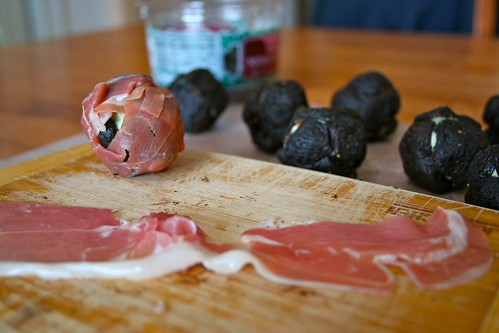This recipe is part of the “Celebratory Goose Dinner” miniseries. For the complete menu, timetable, and printable shopping list, see the introductory post.

Finally, we get to the goose. This entire saga started back in December when I entered a contest on Jessie Cross’s blog, The Hungry Mouse. (How could I not be a reader of this blog? We’re both from MA, we’re both hungry, and more to the point, it’s GOOD. Check it out.) She had recently connected with Connie at Sassafras Valley Farm, a free-range family goose farm in MO. After preparing goose three ways herself and posting a robust goose primer on her blog, Jessie celebrated by holding a giveaway where one of her readers would win a goose to try themselves.
Now, some of you are already well aware of this, but I have a serious illness when it comes to free things. I can’t help myself; I am a contest-entering junkie. Somewhere along the way, I picked up a hearty helping of luck, because I seem to win more than my fair share. My favorite types of giveaways are the ones where you compete for prizes — I’m pretty sure that Starbucks’ 2006 crossword puzzle/scavenger hunt contest was the highlight of my year. In fact, you’ve seen a couple of my contest entries here already. (Did I mention that I won third place in the Sew, Mama, Sew! tablescapes contest back in September? So cool! I won a free Craftsy class, $15 of fabric from Sew, Mama, Sew! and a set of Aurifil thread…) But now I truly digress.
Fast forward to December 5th, 2012, when Jessie announced that I had won a free goose courtesy of Connie at Sassafras Valley Farm! (I’d like to insert here that my grandmother’s name is Connie, and one of my aunts is affectionately called Sassafras…coincidence?) I was, of course, ecstatic. In truth, I was so excited that I couldn’t fall asleep until 1:30 that night due to images of Dickensian Christmas dinners dancing in my head. A goose! I named her Esmerelda, sight unseen.
I had never tried goose before, and embraced the challenge. My biggest fear heading into it was that I would burn the house down or battle excessive smoking. Thankfully, neither occurence came to pass. It was not, however, a perfect goose. (I’m sorry Esme, of course YOU’RE perfect… It was me, not you.) Let me elaborate by way of segue into the cooking tips:
First and foremost, please, please, please don’t overcook your goose! If you should overcook the goose, it won’t burn, and it won’t become dry; it will become tough. The goose was in fact tasty, but my first inkling that I might have overcooked her was when I had to go back out to the kitchen for steak knives. But I still wasn’t sure. Maybe that’s normal. It tasted good; it was simply a bit of a mouthful to chew, and wasn’t as mouth-wateringly delicious as I had hoped it might be. The thought gnawed at the recesses of my brain for the rest of the night. Did I…? Was it…? As Mr. M and I were lying in bed that night recapping the evening to each other, the discussion turned to the goose.
“So, what did you think of the goose itself?” I asked tentatively.
Pause. I can see what he thinks by the look on his face.
“Well, I mean, it wasn’t bad, and I thought the seasonings were really good, but…”
Sigh. “Yeah, I know. Was it the texture? I mean, I did think it was a little chewy, so I’m wondering if maybe I…”
“I don’t know, I think I might just not be a fan of goose in general. It kinda tasted like… liver to me.”
My heart sunk. Confirmation that I had overcooked the goose. Just the day before I had received an e-mail from Connie with the following words of advice: “Over roasting a chicken doesn’t alter the flavor. It just makes it dry. Over roasting a goose does… it will taste livery.”
So what happened? There was a 20 degree difference between the temperature listed in the recipe I selected and the temperature recommended by Connie and Jessie. I tried to compromise and split the difference. Don’t do this. Please. Listen to the woman who actually raised the goose and shoot for a final temperature of 165. I’ve adjusted the times and temperatures in the recipe below to reflect how I would make this recipe if I were to attempt it again, so you can learn from my mistake!
A second alteration I made was to swap out a few ingredients. First I traded out the cardamom from the original recipe in favor of allspice, based on Connie’s recommendation. It worked. I also had some lingonberry preserves on hand and loved the idea of lingonberries and goose, so I used those in the sauce (the original recipe calls for cranberries). The sauce was fabulous, and I look forward to trying it with other types of poultry as well. As a matter of personal preference, I think I might also use red potatoes instead of gold next time — I just prefer their texture.
Finally, the original recipe calls for the bird to be pricked all over prior to cooking so the fat can be released, but does not actually score the goose. Jessie’s blog post does an excellent job detailing the scoring process both in photos and words, so I won’t repeat it here, but, yeah. Do that. Connie recommends this as the best method to avoid rubbery skin, and frankly, it looks cool and was fun to try. Plus, I’m always looking for my next big score.
Orange & Thyme Roasted Goose with Potatoes, Shallots and a Lingonberry-White Wine Sauce
Adapted by The Hungry Crafter from Whole Foods Market
- 7-8 pound whole goose (defrosted 3 days if frozen)
- Salt and pepper
- Zest and juice from 1 large orange (reserve squeezed halves)
- 8 sprigs thyme plus 1 tablespoon finely chopped thyme leaves
- ⅓ cup orange marmalade
- 1 teaspoon allspice
- 5 large yellow potatoes (about 3¾ pounds), cut into large chunks
- 1 pound large shallots, peeled and halved
- 1 cup dry white wine
- ½ cup prepared lingonberry preserves
- 2 bay leaves
- 2 teaspoons flour
Take goose out of the refrigerator and keep at room temperature about an hour before you’d like to begin roasting it. Meanwhile, preheat oven to 375°F.

Remove neck and giblets from the cavity of the goose (discard or, preferably, freeze for use in making stock), then thoroughly rinse inside and out with cool, running water. Indulge me for a second while I point out that the heart was perfectly, um, heart-shaped. Wild.

Pat the goose dry with paper towels and transfer to a roasting pan. With a sharp knife, gently score the bird in a diamond-shaped pattern as pictured below by cutting diagonal lines across one side of the bird and then crisscrossing the lines in the other direction. You want to cut through the skin and the thick layer of fat underneath, but not go so deep so as to expose the meat below. Erm, so yeah, NOT like the picture below in that regard. Pretend those purple-blue areas peeking through aren’t there. But don’t worry about it too much if yours do as well.

Prick the skin all over with a fork. Season the goose generously inside and out with salt and pepper. Transfer zest and juice from orange to a small bowl, then tuck squeezed orange halves and thyme sprigs into cavity of goose; set aside. Add orange marmalade, chopped thyme and allspice to bowl with orange zest and juice and stir to combine. Baste goose all over with half of the orange mixture and roast until deep golden brown, 35 to 40 minutes.

Carefully remove roasting pan from oven and transfer accumulated fat in the pan to a heatproof bowl (I used a baster to draw up the fat); set aside.
Put potatoes, shallots, 2 tablespoons of the goose fat, salt and pepper into a large bowl and toss to combine. (You can freeze the remaining goose fat at this point for later use. Please don’t throw it away! The stuff is liquid gold. Try frying…well, just about anything in it and you’ll see.)
Arrange potatoes and shallots around goose, loosely tent the goose with foil, and continue to roast for 30 minutes. You can also cover the wing tips with foil if they are cooking too fast. To help ensure even cooking, cut the legs so they flop open to the sides (see below).

When 30 minutes are up, baste the goose with remaining orange mixture and remove any excess fat that’s accumulated in the pan. Continue roasting, tossing potatoes and shallots and basting goose every 30 minutes, until a thermometer inserted in the thickest part of the thigh registers about 155°F, about 1 more hour. Stir potatoes and shallots, uncover goose (reserve the foil) and continue roasting until skin is crisp and thermometer reads 160°F, about 10 more minutes. Carefully transfer goose, potatoes and shallots to a large serving platter, tent with foil, and set aside. Note: check your potatoes for doneness with a fork — if they need more time, transfer them to a baking dish and let them continue to cook while the goose rests. Let goose rest for 30 minutes before carving. 
Time to make the gravy! Skim off and discard any fat from the pan juices, then bring to a boil over medium-high heat (I put the roasting pan right on the stove top, but you can also transfer the drippings to a saucepan if you prefer). Whisk in wine and lingonberry preserves then add bay leaves and boil gently until reduced and just thickened, 3 to 4 minutes. Whisk in flour and cook 1 to 2 minutes more. Remove sauce from heat, discard bay leaves, season with salt and pepper to taste, and transfer to a small bowl or gravy boat. Carve goose and serve hot with potatoes, shallots and lingonberry-white wine sauce on the side.
Tips from The Hungry Crafter:
- You may notice that the potatoes are not in the pics with the goose — this was a result of the timing in the original recipe I used. In order to avoid overcooking the goose and undercooking the potatoes…well, imagine the potatoes are in those pics, and follow the written word.
- If, like myself, you need a few pointers on carving a goose, check out this tutorial on Martha Stewart.
- Favorite product alert — I absolutely adore the flat whisk my mother-in-law got me a few years ago. What a difference this shape makes for gravies and pan sauces compared to a standard balloon whisk!
- If you can’t find lingonberry preserves, check out your local IKEA store…that’s where I got mine.
- It should go without saying, but…if you are looking to buy a goose, check out Sassafras Valley Farm!
Read Full Post »



























